
Facial piercings are a vibrant form of self-expression‚ offering personalized style and beauty․ With rising popularity‚ they allow individuals to enhance their features and showcase unique aesthetics․ This guide provides essential insights into types‚ care‚ and considerations for a safe‚ stunning piercing experience․
Overview of Facial Piercings
Facial piercings are a popular form of self-expression‚ offering a way to enhance one’s features and showcase personal style․ They come in various types‚ each with unique placement and aesthetic appeal․ From subtle options like nostril or labret piercings to more striking choices such as bridge or jestrum piercings‚ there’s something for every preference․ Proper aftercare is essential to ensure healing and prevent complications․ Understanding your face shape and anatomy helps in choosing the most flattering piercing․ With careful selection and proper maintenance‚ facial piercings can be a beautiful and meaningful addition to one’s appearance․
Popularity and Trends in Facial Piercings
Facial piercings have gained significant popularity as a form of self-expression and body art․ Trends include septum‚ eyebrow‚ and labret piercings‚ with many embracing bold styles like snake bites and anti-eyebrow piercings․ Social media and celebrity influences have further fueled their appeal‚ making them a mainstream fashion statement․ As more people explore unique ways to enhance their features‚ facial piercings continue to evolve‚ offering countless options for personalization․ Their versatility allows individuals to tailor their look to suit their style‚ face shape‚ and confidence‚ making them a timeless and trendy choice for those seeking to stand out․
Importance of Research Before Getting a Facial Piercing
Research is crucial before committing to a facial piercing․ Understanding the piercing process‚ aftercare‚ and potential risks ensures a safe and satisfying experience․ Investigating reputable piercers and studios is vital‚ as improper techniques can lead to complications․ Learning about jewelry materials and styles helps in making informed decisions․ Additionally‚ knowing how piercings suit your face shape and personal style avoids regret․ Proper preparation and realistic expectations are key to a positive outcome․ Taking the time to gather information ensures confidence and a successful piercing journey‚ both aesthetically and health-wise․
Types of Facial Piercings
Facial piercings offer diverse options‚ each with unique styling and self-expression․ From subtle to bold‚ they cater to various preferences‚ enhancing facial features and personal aesthetics beautifully․
Eyebrow Piercing
An eyebrow piercing is a popular choice‚ offering versatility in placement and style․ It can be positioned anywhere along the brow‚ from the outer corner to the arch‚ creating a bold or subtle look․ This piercing is ideal for those seeking a striking facial feature that draws attention․ Healing typically takes 6-8 weeks‚ with proper care․ Pain levels are moderate‚ but the result is well worth it․ Jewelry options include studs‚ rings‚ or curved barbells; While trendy‚ it requires commitment to aftercare to prevent complications and ensure a smooth healing process․
Nose Piercing
Nose piercings are among the most popular facial piercings‚ known for their elegance and versatility; They can be placed on the nostril‚ septum‚ or bridge‚ offering diverse styling options․ Nostril piercings are particularly favored for their subtle yet striking appearance‚ while septum piercings provide a bold‚ edgy look․ Healing typically takes 6-12 months‚ with proper care essential to prevent infections․ Pain levels vary‚ but the procedure is generally manageable․ Jewelry choices include rings‚ studs‚ and hoops‚ allowing for personalization to suit individual aesthetics․ Nose piercings are a timeless choice‚ blending seamlessly with various facial features and styles․
Septum Piercing
A septum piercing is a bold and edgy facial piercing located between the nostrils‚ showcasing a ring or jewelry in the nasal septum․ Known for its striking appearance‚ it’s a popular choice for those seeking a unique aesthetic․ Healing typically takes 6-8 weeks‚ with proper care essential to avoid complications․ The procedure involves piercing the thin cartilage‚ and professional expertise is crucial to ensure accuracy and minimize discomfort․ Jewelry options include hoops‚ clickers‚ and studs‚ offering versatility in styling․ Septum piercings are reversible‚ making them a favorite among those exploring facial modifications without long-term commitment․
Labret Piercing
A labret piercing is a facial piercing located on the lower lip‚ typically below the mouth․ It’s a popular choice for its bold yet elegant appearance․ The piercing involves inserting jewelry‚ often a labret stud or ring‚ through the lip’s flesh․ Healing typically takes 6-8 weeks‚ with proper aftercare essential to prevent complications․ The labret piercing offers versatility in styling‚ accommodating various jewelry types and sizes․ Its placement enhances facial symmetry‚ making it a favorite for those seeking a striking‚ customizable look․ With minimal maintenance and the right care‚ it remains a timeless choice in facial piercings․
Cheek Piercing
A cheek piercing involves puncturing the facial tissue to create a passage for jewelry․ It is often positioned to resemble dimples‚ enhancing the face’s natural contours․ This piercing is popular for its aesthetic appeal and customization options․ Healing can take several months‚ requiring diligent aftercare to avoid complications․ Cheek piercings are typically surface piercings‚ with jewelry like studs or hoops commonly used․ They add a unique touch to one’s appearance‚ making them a favored choice among those seeking distinctive facial modifications․ Proper care is crucial to ensure a smooth healing process and maintain the piercing’s visual appeal․
Bridge Piercing
A bridge piercing is a surface piercing located on the bridge of the nose‚ offering a unique and striking appearance․ It involves inserting jewelry‚ typically a barbell or stud‚ through the skin․ This piercing is popular for its edgy aesthetic and versatility․ However‚ it carries a higher risk of rejection due to the bridge’s tight skin․ Healing requires meticulous aftercare to prevent complications․ Ideal for those seeking a bold‚ modern look‚ bridge piercings are a standout choice for facial modifications‚ though they may not suit all face shapes or personal styles․ Proper anatomy and professional technique are crucial for success․

Jestrum Piercing
The Jestrum piercing‚ also known as the soul patch piercing‚ is a surface piercing located beneath the nose‚ near the Cupid’s bow․ It adds a subtle yet striking detail to the face․ This piercing is typically adorned with barbells or studs‚ enhancing its visual appeal․ Due to its placement‚ proper anatomy is essential to avoid complications․ Healing requires consistent aftercare to minimize risks․ Ideal for those seeking a unique‚ understated look‚ the Jestrum piercing offers a modern twist to facial aesthetics‚ though it may not suit all face shapes or personal styles․ Professional expertise is recommended for optimal results․
Lip Piercing
Lip piercings are a popular choice for those seeking a bold‚ eye-catching aesthetic․ They can be placed anywhere on the lip‚ from the center to the sides‚ offering versatility in style․ Common jewelry options include rings‚ studs‚ or labret jewelry‚ depending on the desired look․ Healing typically takes 2-4 months‚ with proper aftercare essential to prevent swelling and infection․ Lip piercings are ideal for those who want to make a statement‚ but they may require adjustments to avoid irritation from speaking or eating․ Regular cleaning and avoiding tight jewelry can ensure a smooth healing process and a striking result․
Philtrum Piercing
The philtrum piercing is a delicate and elegant choice‚ located in the small groove between the nose and upper lip․ This piercing enhances facial symmetry and adds a subtle touch of beauty․ Typically adorned with a small stud or hoop‚ it complements various face shapes‚ especially oval and heart-shaped faces․ Healing usually takes 6-8 weeks‚ with proper aftercare crucial to avoid complications․ The philtrum piercing is ideal for those seeking a refined yet noticeable addition to their appearance‚ offering a classic and timeless appeal that pairs well with other facial features and jewelry styles․
Vertical Labret Piercing
The vertical labret piercing is a unique variation of the traditional labret‚ featuring a vertical placement that starts below the lip and extends upward toward the chin․ This piercing offers a striking aesthetic‚ making it a popular choice for those seeking a bold yet elegant look․ Typically adorned with a curved barbell‚ it complements round and oval face shapes․ Healing takes 3-6 months‚ requiring diligent aftercare to prevent complications․ The vertical labret is perfect for individuals wanting a standout piercing that adds dimension and character to their facial features while maintaining versatility in jewelry style․
Snake Bites Piercing
Snake bites piercing consists of two separate piercings on the lower lip‚ typically spaced evenly apart․ This edgy design mimics the appearance of snake fangs‚ creating a striking and bold aesthetic․ Ideal for those with heart-shaped faces‚ snake bites add balance and contrast to the jawline․ The healing process usually takes 6-8 weeks‚ with proper aftercare essential to avoid complications․ This piercing is a favorite among those seeking a rebellious yet sophisticated look‚ offering versatility in jewelry choices like studs or hoops to enhance its unique appeal and personal style․
Anti-Eyebrow Piercing
The anti-eyebrow piercing is a unique surface piercing located just below the eyebrow‚ typically over the cheekbone․ It adds a striking‚ asymmetrical touch to the face․ Suitable for those seeking a bold yet subtle look‚ this piercing is ideal for individuals with angular or oval face shapes․ The healing process usually takes 6-12 months‚ requiring careful aftercare to prevent complications․ Jewelry options include curved barbells or studs‚ enhancing its edgy aesthetic․ This piercing is perfect for those looking to make a statement while maintaining a sophisticated appearance‚ offering a modern twist to traditional facial piercings․
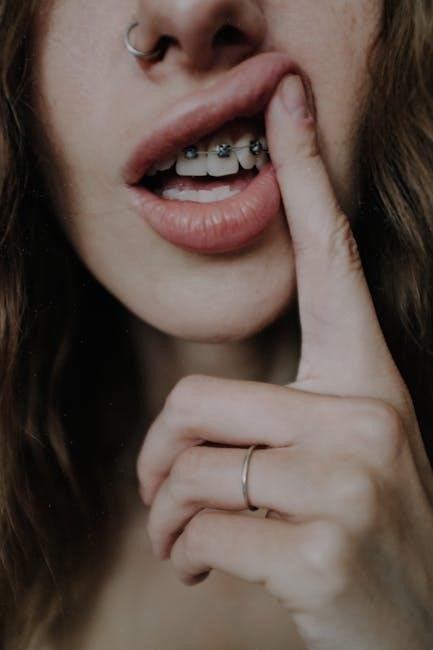
Considerations Before Getting a Facial Piercing
Researching face shape‚ anatomy‚ and piercing types is crucial for a flattering and safe experience․ Professional consultation ensures proper placement and minimizes risks‚ promoting optimal results․
Determining Your Face Shape
Understanding your face shape is key to choosing the right piercing; Oval faces are balanced and versatile‚ while round faces benefit from elongating piercings like septum or eyebrow․ Square faces suit softening features with labret or lip piercings‚ and heart-shaped faces look great with piercings that draw attention downward․ Measure your face length‚ cheekbones‚ and jawline to identify your shape․ Oval faces are longest‚ with balanced proportions․ Round faces are widest at the cheeks‚ while square faces have strong jawlines․ Heart-shaped faces are broader at the temples․ This step ensures your piercing complements your natural features for a harmonious look․

Choosing the Right Piercing for Your Face Shape
When selecting a facial piercing‚ consider your face shape to enhance your natural features․ Oval faces suit versatile options like eyebrow or septum piercings․ Round faces benefit from elongating styles‚ such as nostril or labret piercings․ Square faces soften with curved designs like lip or cheek piercings․ Heart-shaped faces look stunning with piercings that draw attention downward‚ such as snake bites or vertical labrets․ Research and consult a professional piercer to find the perfect match for your unique anatomy‚ ensuring a balanced and flattering aesthetic tailored to your face shape․
Round Faces: Suitable Piercings
Round faces benefit from piercings that create elongation or balance․ Nostril and septum piercings are popular choices‚ as they draw attention vertically․ Labret piercings‚ placed below the lip‚ can also complement round faces by adding definition․ Avoid overly bulky jewelry that may accentuate width; Instead‚ opt for delicate studs or hoops to maintain a balanced look․ Consulting a professional piercer can help determine the most flattering placement for your features․ This ensures a harmonious blend of style and facial symmetry‚ enhancing your natural beauty while maintaining a proportional aesthetic․
Oval Faces: Suitable Piercings
Oval faces are often considered ideal for a variety of piercings due to their balanced proportions․ Eyebrow and septum piercings are particularly flattering‚ as they enhance symmetry without disrupting the face’s natural harmony․ Labret piercings‚ placed below the lip‚ can also complement oval faces by adding a touch of elegance․ Vertical jewelry placements‚ such as bridge piercings‚ can create a slimming effect‚ while subtle studs or hoops in the nostril or lip areas add a delicate‚ polished look․ Oval faces can pull off both bold and minimalistic styles‚ making them versatile for various piercing options․
Understanding Facial Anatomy for Piercings
Understanding your facial anatomy is crucial for safe and aesthetically pleasing piercings․ Each face has unique features‚ such as the curvature of the nose‚ the shape of the jawline‚ and the structure of the lips․ Proper placement ensures jewelry sits comfortably and complements natural contours․ For eyebrow piercings‚ the brow bone’s thickness is considered to avoid nerve damage․ Similarly‚ nose and septum piercings require knowledge of cartilage and soft tissue to prevent complications․ A skilled piercer studies your anatomy to recommend placements that enhance your features while ensuring safety and optimal healing outcomes․
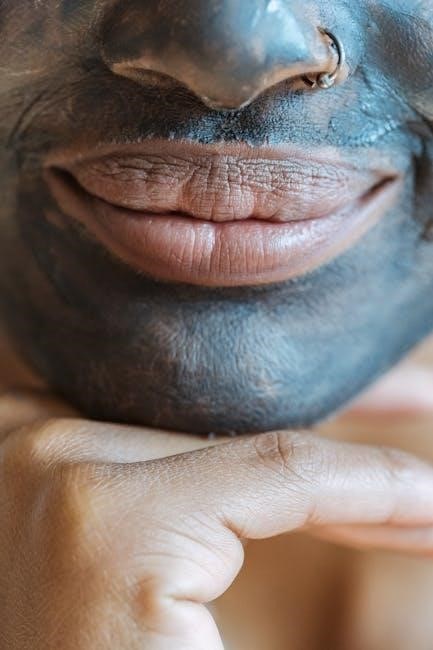
The Piercing Process
Facial piercings involve precise techniques performed by professional piercers to ensure safety and aesthetics․ The process is brief but requires attention to hygiene and proper jewelry placement․
Preparation for the Piercing
Proper preparation is essential for a safe and successful piercing experience․ Start by researching reputable studios and professional piercers to ensure high standards of hygiene and expertise․ On the day of the piercing‚ arrive well-rested and hydrated to minimize stress․ Avoid consuming alcohol or caffeine‚ as these can increase sensitivity․ Your piercer will guide you through the process‚ marking the area carefully to ensure precise placement․ Maintaining a clean environment and using sterilized equipment are critical to reduce infection risks․ Choosing the right jewelry for your piercing is also an important step‚ as it affects both aesthetics and healing․ Be prepared to follow aftercare instructions diligently to promote proper healing․
The Piercing Procedure
The piercing procedure involves a sterile environment and precise techniques to ensure safety and accuracy․ A professional piercer uses a hollow needle to create the piercing‚ often following pre-marked points for alignment․ The process is quick‚ with the jewelry inserted immediately after the needle passes through․ While some discomfort is normal‚ experienced piercers minimize pain through careful execution․ The environment is kept clean‚ and all equipment is sterilized to prevent infections․ The piercer will also provide immediate aftercare instructions to support the healing process․ Their expertise ensures the piercing is done safely and correctly‚ enhancing your desired aesthetic outcome․
Pain Management During Piercing

Pain management during facial piercings varies depending on individual tolerance and the piercing type․ Professional piercers use sterile‚ high-quality tools and techniques to minimize discomfort․ Topical anesthetics or numbing creams may be used to reduce sensitivity․ Breathing exercises or mental preparation can also help alleviate anxiety․ The procedure is typically quick‚ with discomfort subsiding shortly after․ Piercers often recommend staying relaxed and following instructions to ensure a smooth experience․ While some pain is inevitable‚ the process is designed to be as comfortable as possible‚ with the end result often outweighing the temporary discomfort․
Aftercare and Healing
Proper aftercare is crucial for healing facial piercings․ Keep the area clean with saline solution‚ avoid tight clothing‚ and monitor for signs of complications․ Consistent care ensures optimal results․
General Aftercare Tips
Proper aftercare is essential for healing facial piercings․ Clean the area daily with saline solution‚ and avoid submerging it in water until fully healed․ Keep the piercing dry and avoid touching it unnecessarily‚ as this can introduce bacteria․ Refrain from using harsh products like hydrogen peroxide or alcohol‚ as they can irritate the skin․ Avoid tight clothing that may rub against the piercing․ Monitor for signs of infection‚ such as redness‚ swelling‚ or discharge‚ and seek professional advice if concerns arise․ Consistent care ensures a smooth and healthy healing process․
Healing Time for Different Piercings
Healing times for facial piercings vary depending on the type and location․ Eyebrow piercings typically heal within 6-8 weeks‚ while septum piercings may take 6-8 months․ Lip and labret piercings usually heal in 2-4 months‚ and cheek piercings can take 3-6 months․ Bridge piercings often require 6-12 months for full healing․ Proper aftercare is crucial to prevent infections and ensure a smooth recovery․ Each piercing has unique needs‚ so understanding the specific healing timeline for your piercing type is essential for optimal results․ Patience and consistent care are key to achieving a fully healed‚ healthy piercing․
Common Mistakes to Avoid During Healing
During the healing process‚ it’s crucial to avoid common mistakes that can delay recovery or lead to complications․ Over-touching the piercing can introduce bacteria‚ increasing infection risk․ Using harsh cleaning products or submerging the piercing in unhygienic water should be avoided․ Neglecting to follow aftercare instructions‚ such as soaking or cleaning schedules‚ can hinder healing․ Tight or ill-fitting jewelry can cause irritation‚ while playing with the jewelry prolongs healing time․ Ignoring signs of infection‚ like redness or swelling‚ can lead to serious issues․ Patience and adherence to proper aftercare are essential for a smooth recovery․
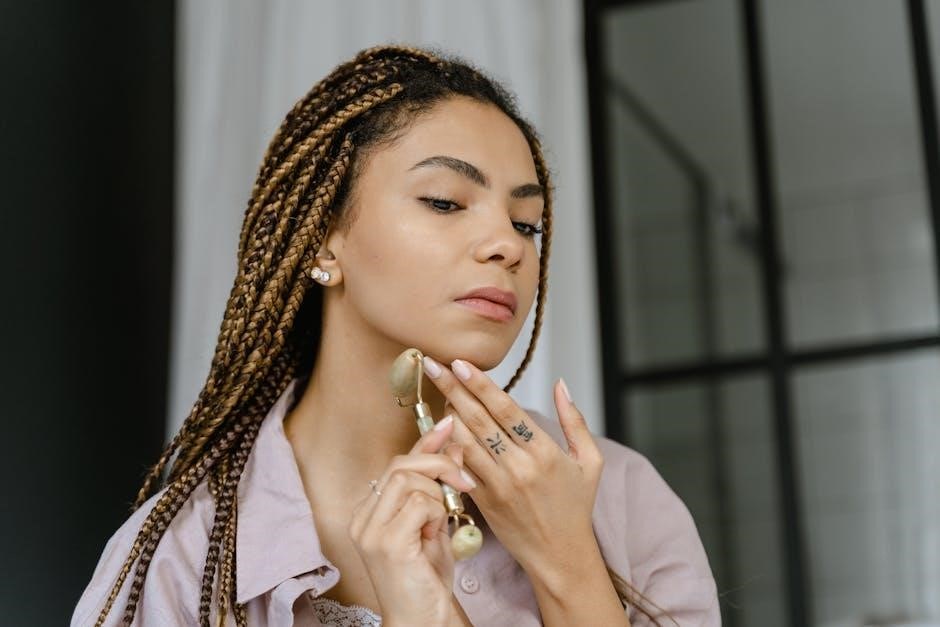
Risks and Complications
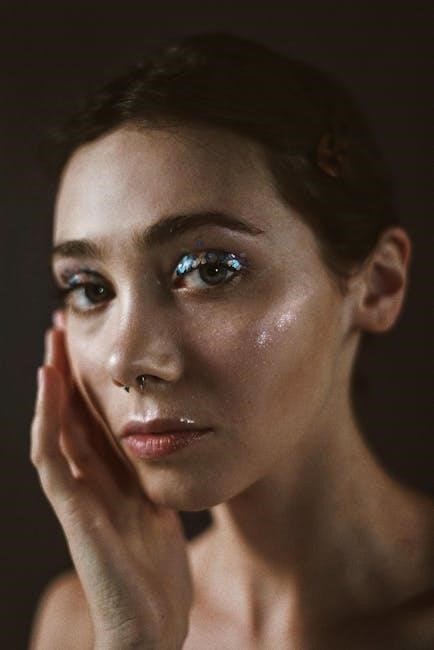
Facial piercings carry risks like infections‚ allergic reactions‚ and scarring․ Improper technique or jewelry can lead to nerve damage or prolonged healing․ Awareness is key to minimizing complications․
Possible Risks of Facial Piercings
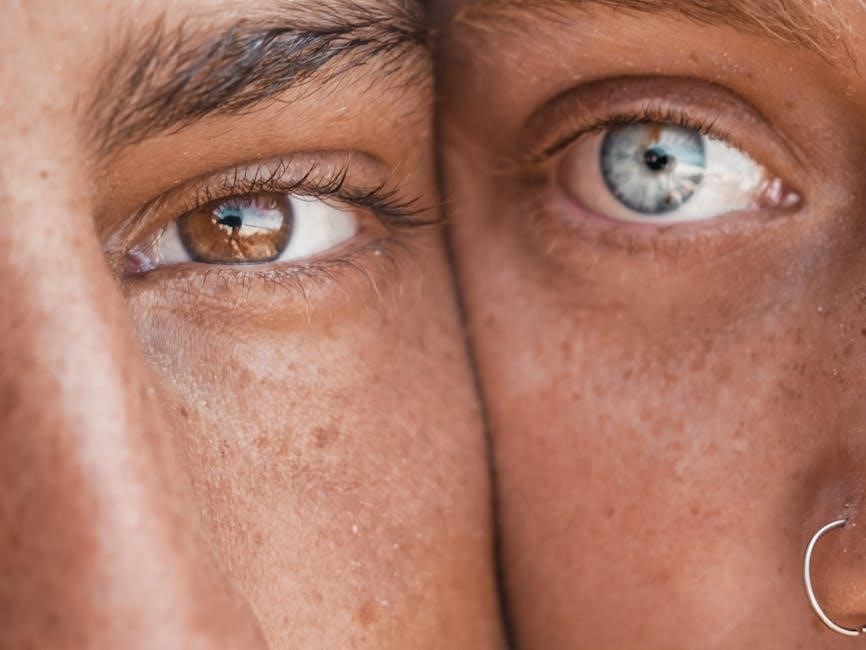
Facial piercings can lead to infections‚ allergic reactions‚ or scarring if not properly cared for․ Nerve damage and keloid formation are rare but potential complications․ Proper aftercare and professional guidance are essential to minimize these risks and ensure a smooth healing process․
How to Prevent Infections
Preventing infections in facial piercings requires diligent aftercare․ Gently clean the area with saline solution twice daily‚ avoid submerging the piercing in water‚ and keep jewelry clean․ Avoid touching the piercing unnecessarily and ensure all materials used are sterile․ Proper hygiene practices significantly reduce the risk of complications and promote healing․ Following professional advice and maintaining a healthy lifestyle also supports a smooth recovery process․
When to Seek Medical Attention
If you notice signs of infection‚ such as increased redness‚ swelling‚ or discharge‚ seek medical attention promptly․ Persistent pain or unusual symptoms like fever or red streaks around the piercing are alarming․ Consult a professional piercer or doctor if healing is delayed or if jewelry causes discomfort․ Timely intervention prevents complications and ensures proper recovery․ Don’t hesitate to act if something feels off‚ as early treatment is key to avoiding serious issues․
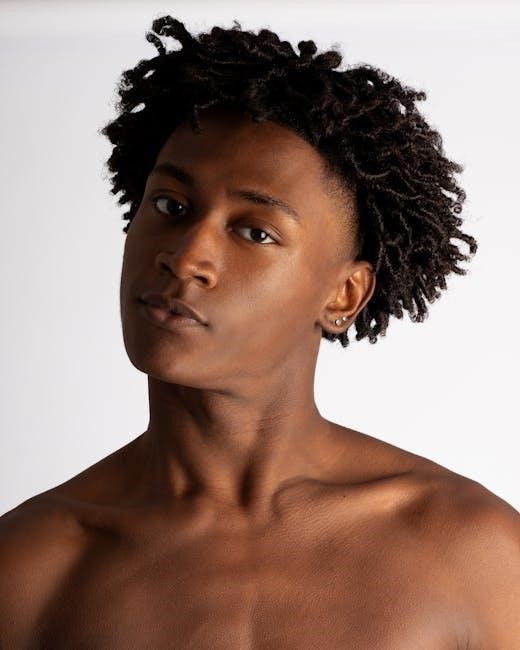
Choosing the Right Jewelry
Selecting the right jewelry for facial piercings is crucial for comfort and aesthetics․ Opt for high-quality‚ hypoallergenic materials like surgical stainless steel or titanium to minimize irritation․ Consider the size and fit to ensure the jewelry sits properly without causing discomfort․ Hoops‚ studs‚ and rings are popular choices‚ but the style should complement the piercing location and your personal taste․ Always prioritize safety and durability to maintain the health of your piercing and achieve the desired appearance․
Types of Jewelry for Facial Piercings
Facial piercings offer a variety of jewelry options to suit personal style and anatomy․ Studs‚ hoops‚ and rings are popular choices‚ with labs and barbells also being common․ Circular barbells and curved barbells are ideal for certain placements‚ while captive bead rings add a sleek look․ For lip piercings‚ labret jewelry is a favorite‚ offering both functionality and aesthetics․ Each type of jewelry is designed to complement specific piercing locations‚ ensuring comfort and visual appeal․ Consider your face shape‚ piercing placement‚ and personal preference when selecting jewelry to enhance your unique look․
Materials Safe for Piercings
Choosing the right jewelry material is crucial for safe facial piercings․ Surgical stainless steel (316L) is highly recommended due to its hypoallergenic properties and durability․ Titanium is another excellent option‚ as it is lightweight‚ corrosion-resistant‚ and biocompatible․ Solid 14k or 18k gold is also safe‚ though it should be nickel-free to avoid allergic reactions․ Avoid low-quality metals like sterling silver for initial piercings‚ as they can cause irritation․ Always opt for materials that meet ASTM or ISO standards to ensure safety and minimize the risk of complications during the healing process;
Size and Fit Considerations
Proper sizing and fit are essential for comfortable and safe facial piercings․ Jewelry should snugly fit the piercing without being too tight‚ as this can cause discomfort or restrict blood flow․ Common gauges for facial piercings range from 16g to 18g‚ with smaller gauges being less visible․ The length of studs or hoops should accommodate the piercing’s depth and any swelling during healing․ For example‚ bridge piercings often use shorter jewelry‚ while labret piercings may require longer studs․ Always consult a professional piercer to determine the ideal size and fit for your specific anatomy and piercing type to ensure optimal comfort and aesthetics․
Maintenance and Upkeep
Regular maintenance is crucial for keeping facial piercings clean and safe․ Daily cleaning with saline solution‚ avoiding harsh products‚ and periodically checking jewelry fit ensures comfort and safety․
Cleaning and Hygiene Practices
Proper cleaning is essential for maintaining healthy facial piercings․ Use a saline solution (1/4 teaspoon of sea salt in 8 oz of warm water) for daily soaks or rinses․ Gently pat dry with a clean towel․ Avoid harsh chemicals or abrasive products‚ as they can irritate the skin․ Wash hands thoroughly before touching the piercing․ Avoid submerging the piercing in unclean water‚ such as swimming pools or hot tubs‚ to prevent infection․ Regular cleaning helps promote healing and prevents complications‚ ensuring your piercing remains safe and visually appealing․
Changing Jewelry Safely
Changing jewelry in facial piercings requires careful attention to avoid irritation or damage․ Always wait until the piercing is fully healed before making any changes․ Wash your hands thoroughly with soap and water‚ and ensure the jewelry is sterilized․ Use a clean‚ high-quality piece made from safe materials like surgical stainless steel or titanium․ If the jewelry is difficult to remove‚ consider using forceps or seek assistance from a professional piercer․ Avoid using unsterilized tools‚ as this can lead to infection․ Proper handling ensures a smooth transition and maintains the piercing’s health and appearance․
Long-Term Care for Piercings
Long-term care for facial piercings involves maintaining cleanliness and avoiding irritants․ Regularly clean the area with saline solution‚ and avoid harsh chemicals or products․ Check jewelry periodically to ensure it fits properly and isn’t loose․ Avoid playing with or twisting the jewelry excessively‚ as this can cause irritation or scarring․ Protect piercings from extreme temperatures and tight clothing that may rub or damage the area․ Schedule annual check-ups with a professional piercer to assess the piercing’s health and jewelry condition․ Consistent care ensures the piercing remains comfortable and visually appealing for years to come․
Facial piercings offer a unique way to express individuality and enhance beauty․ By choosing the right piercing and following proper care‚ you can enjoy a stylish‚ confident look that reflects your personality․
Final Thoughts on Facial Piercings
Facial piercings are an empowering form of self-expression‚ allowing individuals to enhance their unique beauty and confidence․ With proper care and attention‚ they can become a stunning‚ long-lasting part of your personal style․ Remember‚ piercings are a celebration of individuality‚ so choose one that resonates with your personality and face shape․ Always prioritize safety and hygiene to ensure a positive experience․ Whether subtle or bold‚ facial piercings offer a way to stand out and embrace your true self with elegance and flair․
Encouragement for Safe and Stylish Piercing
Embrace your uniqueness by opting for a facial piercing that complements your style and face shape․ Always prioritize safety by choosing a reputable piercer and high-quality jewelry․ Proper aftercare is key to a smooth healing process and lasting results․ Take your time to research and understand the commitment involved‚ ensuring your piercing reflects your personality․ With patience and care‚ facial piercings can be a beautiful and empowering way to express yourself․ Remember‚ a well-chosen piercing is not just a trend—it’s a celebration of your individuality and confidence․